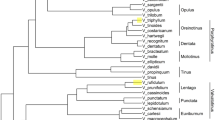Abstract
Dasypyrum is a genus with two species, an annual diploid Dasypyrum villosum and a perennial diploid or tetraploid D. breviaristatum. It is difficult to distinguish between the two, especially for a non-taxonomist. In this paper we demonstrate how to distinguish between the two species and between the two ploidy levels of D. breviaristatum. We achieve this using RAPD analysis to identify potential candidates for marker development and after carrying out principal component analyses and partitioning of genetic variance, developed SCARs and an identification key.




Similar content being viewed by others
References
Baum BR, Nevo E, Johnson DA, Beiles A (1997) Genetic diversity in wild barley (Hordeum spontaneum C. Koch) in the Near East: a molecular analysis using random amplified polymorphic DNA (RAPD) markers. Genet Resour Crop Evol 44:147–157
Baum BR, Edwards T, Johnson DA (2014) What does the nr5S DNA multigene family tell us about the genomic relationship between Dasypyrum breviaristatum and D. villosum (Triticeae: Poaceae)? Mol Genet Genomics 289:553–565. doi:10.1007/s00438-014-0825-5
Chen P, You C, Hu Y, Chen S, Zhou B, Cao A, Wang X (2013) Radiation-induced translocations with reduced Haynaldia villosa chromatin at the pm21 locus for powdery mildew resistance in wheat. Mol Breed 31:477–484. doi:10.1007/s11032-012-9804-x
Das M, Bhattacharya S, Pal A (2005) Generation and characterization of SCARs by cloning and sequencing of RAPD products: a strategy for species-specific marker development in Bamboo. Ann Bot 95:835–841
De Pace C, Snidaro D, Ciaffi M, Vittori D, Ciofo A, Cenci A, Tanzarella OA, Qualset CO, Scarascia Mugnozza GT (2001) Introgression of Dasypyrum villosum chromatin into common wheat improves grain protein quality. Euphytica 117:67–75
Grądzielewska A (2006a) The genus Dasypyrum—part 1. The taxonomy and relationships within Dasypyrum and with Triticeae species. Euphytica 152:429–440. doi:10.1007/s10681-006-9232-2
Grądzielewska A (2006b) The genus Dasypyrum—part 2. Dasypyrum villosum—a wild species used in wheat improvement. Euphytica 152:441–454. doi:10.1007/s10681-006-9245-x
Grądzielewska A, Tyrka M, Lesniowska-Nowak J, Nazaruk J (2014) Genetic relationships among representatives of Dasypyrum, Secale and Triticum species revealed with RAPD and ISSR markers. Not Bot Horti Agrobo 42:420–430. doi:10.1583/nbha4229662
Liu C, Yang Z-J, Feng J, Li GR, Zhou J-P, Chi S-H, Ren ZL (2006) Development of Dasypyrum genome specific marker by using wheat microsatellites. Hereditas (Beijing) 28:1573–1579
Löve Á (1984) Conspectus of the Triticeae. Feddes Repert 95:425–521
Murray TD, De La Pena RC, Yildirim A, Jones SS (1994) A new source of resistance to Pseudocercosporella herpotrichoides, cause of eyespot disease of wheat, located on chromosome 4V of Dasypyrum villosum. Plant Breed 113:281–286
Nkongolo KK, Deverno L, Michael P (2003) Genetic validation and characterization of RAPD markers differentiating black and red spruces: molecular certification of spruce trees and hybrids. Plant Syst Evol 236:151–163. doi:10.1007/s00606-002-0236-7
Ohta S, Koto M, Osada T, Matsuyama A, Furuta Y (2002) Rediscovery of a diploid cytotype of Dasypyrum breviaristatum in Morocco. Genet Resour Crop Evol 49:305–312
Paran I, Michelmore RW (1993) Development of reliable PCR-based markers linked to downy mildew resistance genes in lettuce. Theor Appl Genet 85:985–993
Rohlf FJ (2013) NTSYSpc: numerical taxonomy and multivariate analysis system. Setauket, Exeter Software. Version 2.1
Sneath P, Sokal R (1973) Numerical taxonomy: the principles and practice of numerical classification. W. H. Freeman and Company, San Francisco, pp 129–249
Williams JGK, Kubelik AR, Livak KJ, Rafalski JA, Tingey SV (1990) DNA polymorphisms amplified by arbitrary primers are useful as genetic markers. Nucleic Acids Res 18:6531–6535
Yang ZJ, Li G-R, Feng J, Jiang H-R, Ren Z-L (2005) Molecular cytogenetic characterization and disease resistance observation of wheat-Dasypyrum breviaristatum partial amphiploid and its derivatives. Hereditas 142:80–85. doi:10.1111/j.1601-5223.2005.01918.x
Yang ZJ, Liu C, Feng J, Li GR, Zhou JP, Deng KJ, Ren Z-L (2006) Studies on genome relationship and species-specific PCR marker for Dasypyrum breviaristatum in Triticeae. Hereditas 143:47–54
Zhang Q, Li Q, Wang X, Wang H, Lang S, Wang Y, Wang S, Chen P, Liu D (2005) Development and characterization of a Triticum aestivum-Haynaldia villosa translocation line T4VS·4DL conferring resistance to wheat spindle streak mosaic virus. Euphytica 145:317–320
Acknowledgments
We thank Dr. Shoji Ohta Plant Germplasm Institute, Faculty of Agriculture, Kyoto University, Japan, for sending us material of Dasypyrum breviaristatum that also included the identified diploid and tetraploid cytotypes. The authors would like to thank Harold Bockelman (U.S.D.A) for supplying seed. This research was funded in part by Grants from the Natural Sciences and Engineering Research Council of Canada and the University of Ottawa to D.A.J.
Author information
Authors and Affiliations
Corresponding author
Additional information
M. Hu—On a leave to Agriculture and Agri-Food Canada, Eastern Cereal and Oilseed Research Center, Ottawa, ON, Canada, K1A 0C6.
Rights and permissions
About this article
Cite this article
Hu, M., Baum, B.R. & Johnson, D.A. SCAR markers that discriminate between Dasypyrum species and cytotypes. Genet Resour Crop Evol 64, 505–514 (2017). https://doi.org/10.1007/s10722-016-0376-1
Received:
Accepted:
Published:
Issue Date:
DOI: https://doi.org/10.1007/s10722-016-0376-1




